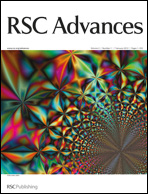Absorption of SO2 from flue gas by aqueous fulvic acid solution†
Abstract
A new regenerable flue gas desulfurization process was proposed, in which fulvic acid derived from biomass residues was used as an absorbent to absorb SO2 from flue gas, based on acid–base buffering capacity. Experiments have been carried out to examine the absorption, desorption and reabsorption performance of fulvic acid solution in a lab-scale reactor. The results show fulvic acid solution (0.04 g mL−1, pH 5.5) could excellently absorb SO2 with a maximum absorption efficiency of 97.5% (298 K, 2200 ppm SO2, 5% O2, 0.14 m3 h−1). In the process of SO2 absorption, chemical absorption is the predominant mechanism. The SO2-loaded solution is readily desorbed and regenerated under ambient pressure by heating at 343 K, and the regenerated fulvic acid solution still exhibits good absorption performance after seven absorption/desorption cycles. Trace metal ions binding to fulvic acid play a decisive role in the absorption process. Fulvic acid samples before and after absorbing SO2 were well characterized by Fourier transform infrared spectroscopy, near-edge X-ray absorption fine structure and X-ray photoelectron spectroscopy. These results demonstrate that no chemical change is found, except that carboxylate groups are protonated to carboxylic groups, indicating that fulvic acid is stable as a regenerable absorbent.


 Please wait while we load your content...
Please wait while we load your content...